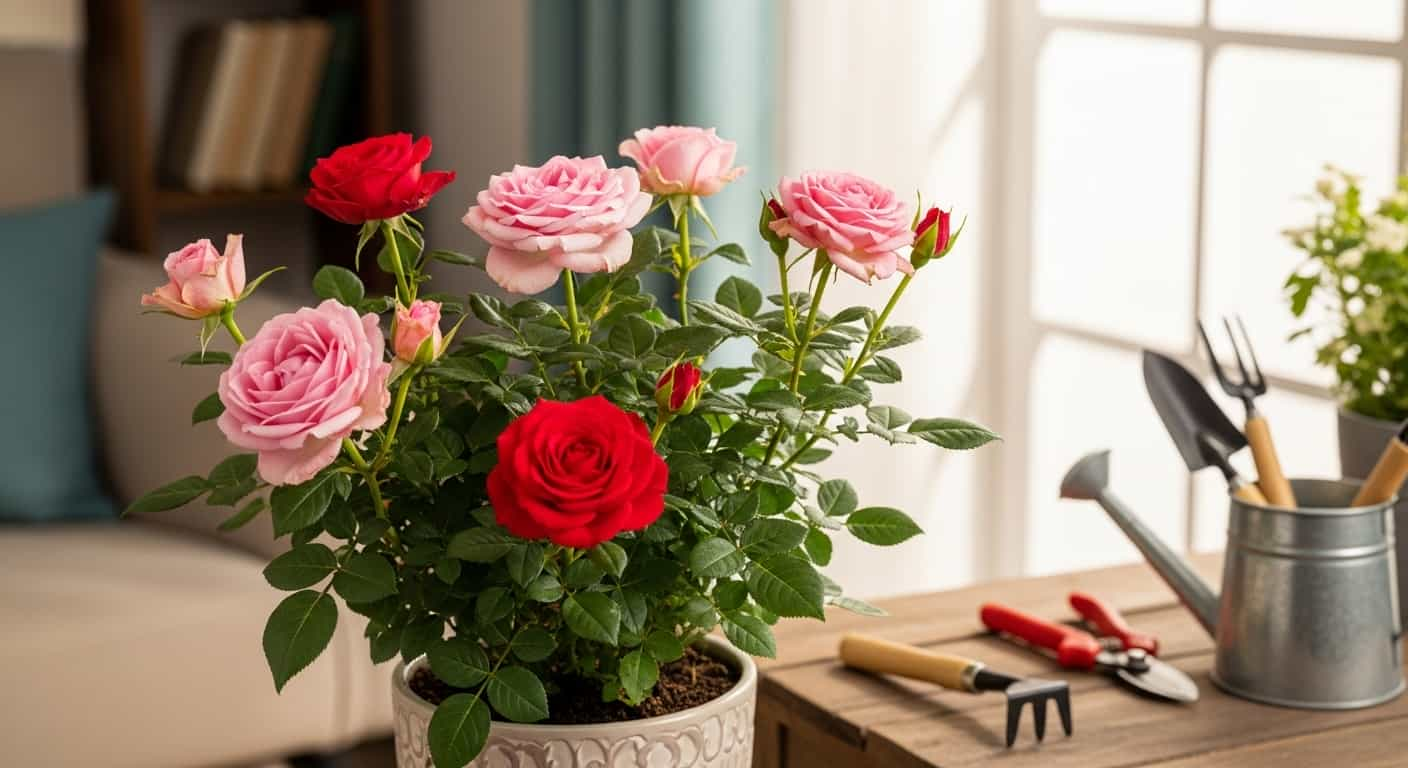Indoor roses bring a touch of elegance and classic beauty to any home. Their delicate blooms and fragrant presence can brighten a room, but keeping them healthy and blooming year-round requires more than just occasional watering. Like their outdoor counterparts, indoor roses are sensitive to the changing seasons. Understanding their needs throughout the year is the key to transforming your home into a personal rose garden.
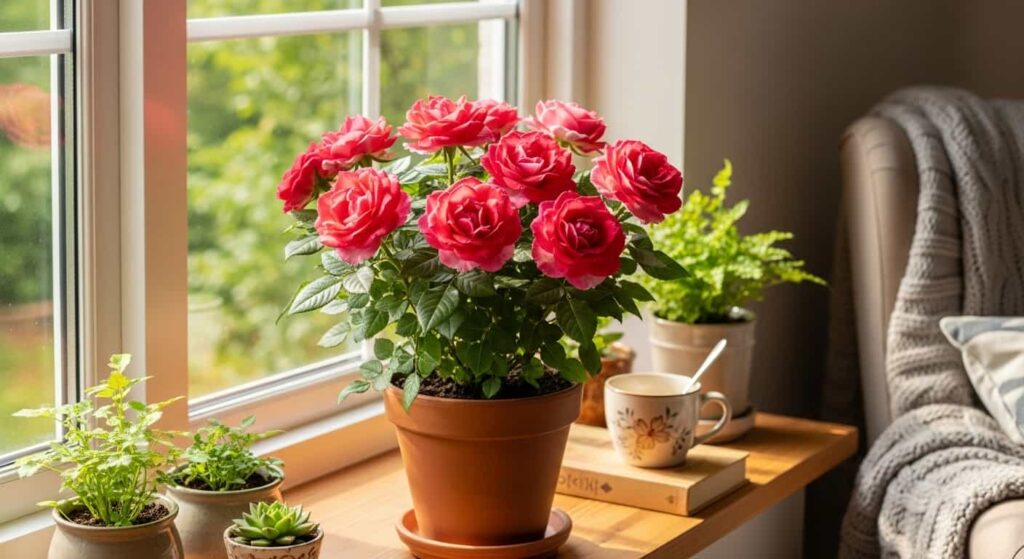
This comprehensive guide will walk you through everything you need to know about seasonal indoor rose care. We will explore the specific actions required for each season—spring, summer, fall, and winter—to ensure your rose plants not only survive but truly thrive. From adjusting your watering schedule to mastering the art of pruning, you will gain the confidence and knowledge needed for successful seasonal gardening indoors.
Spring: A Season of Reawakening and Growth
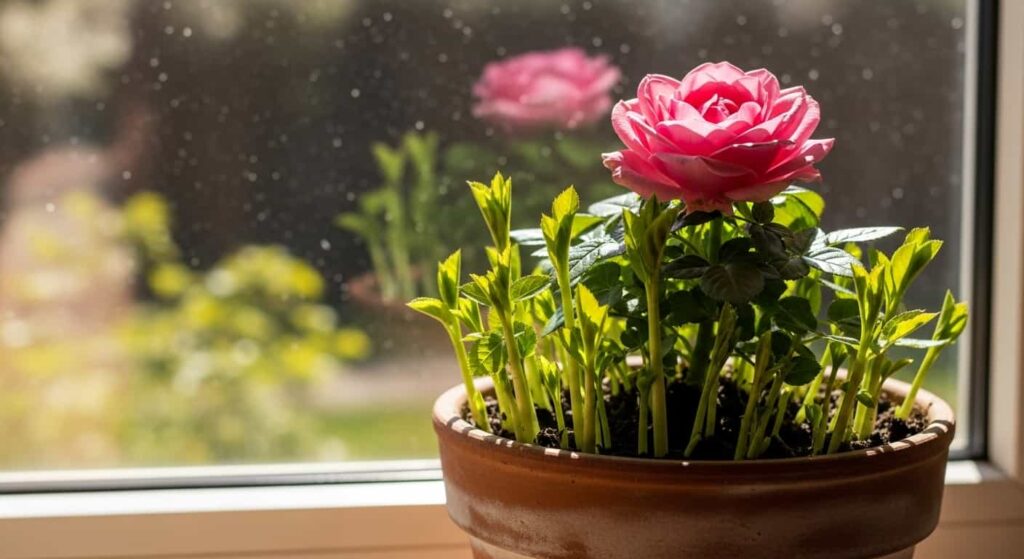
Spring is a critical time for your indoor roses. As the days grow longer and sunlight becomes more intense, your plants will emerge from their winter dormancy and enter a phase of active growth. This is the time to provide them with the right conditions to build a strong foundation for a summer full of beautiful blooms.
Lighting: Maximizing the Spring Sun
After the short, often gloomy days of winter, spring’s increasing sunlight is a welcome change for your roses.
- Placement is Key: Move your rose plant to the sunniest spot in your home, typically a south-facing or west-facing window. They need at least six hours of direct sunlight each day to produce healthy foliage and buds.
- Rotate Regularly: To ensure all parts of the plant receive adequate light, give the pot a quarter turn every few days. This practice prevents the plant from leaning towards the light source and promotes even, balanced growth.
- Consider Supplemental Lighting: If your home doesn’t receive enough natural light, even in spring, a grow light can be a game-changer. Use a full-spectrum LED light positioned about 12 inches above the plant and keep it on for 12-14 hours daily to mimic ideal spring conditions.
Watering: Fueling New Growth
As your rose begins to produce new leaves and shoots, its water requirements will increase significantly. Overwatering remains a risk, so it’s crucial to get the balance right.
- The Finger Test: The most reliable way to check for moisture is to insert your finger about an inch into the soil. If it feels dry at that depth, it’s time to water. If it’s still moist, wait another day or two and check again.
- Water Thoroughly: When you water, do it deeply. Pour water slowly and evenly over the soil surface until it begins to drain from the bottom of the pot. This ensures the entire root ball is hydrated.
- Empty the Saucer: Never let your rose pot sit in a saucer full of water. After watering, wait about 15-20 minutes, then discard any excess water that has collected. Letting the roots sit in water can lead to root rot, one of the most common killers of indoor plants.
Feeding: Providing Essential Nutrients
Think of spring as the start of the growing season’s feast. Your rose has used up many of its stored resources over the winter and now needs nutrients to support vigorous new growth.
- Choose the Right Fertilizer: Use a balanced liquid fertilizer formulated for roses or flowering plants. Look for one with an NPK ratio like 10-10-10 or 20-20-20.
- Start Slow: Begin fertilizing as soon as you see the first signs of new growth. Start with a half-strength solution to avoid shocking the plant.
- Establish a Routine: After the initial feeding, apply fertilizer every two to four weeks throughout the spring. Always follow the instructions on the product label and apply it to moist soil to prevent burning the roots. This consistent feeding is a vital part of your seasonal rose maintenance routine.
Pruning and Repotting: Spring Cleaning for Your Plant
Spring is the perfect time for a little “spring cleaning.” This includes pruning away winter damage and potentially giving your plant a new home.
- Pruning for Health and Shape: Examine your plant for any dead, weak, or crossing branches that may have developed over winter. Use clean, sharp pruning shears to cut these back to a healthy, outward-facing bud. This improves air circulation and directs the plant’s energy toward producing strong, new stems.
- When to Repot: Your indoor rose will likely need to be repotted every two to three years. Spring is the ideal time to do this. Signs that your rose needs a larger pot include roots growing out of the drainage holes, slowed growth, or the soil drying out very quickly.
- How to Repot: Choose a new pot that is only one to two inches wider in diameter than the current one. Use a high-quality potting mix designed for roses, which will provide good drainage. Gently remove the plant from its old pot, loosen the root ball, place it in the new pot, and fill in with fresh soil. Water it well after repotting.
Summer: The Season of Peak Performance and Blooms
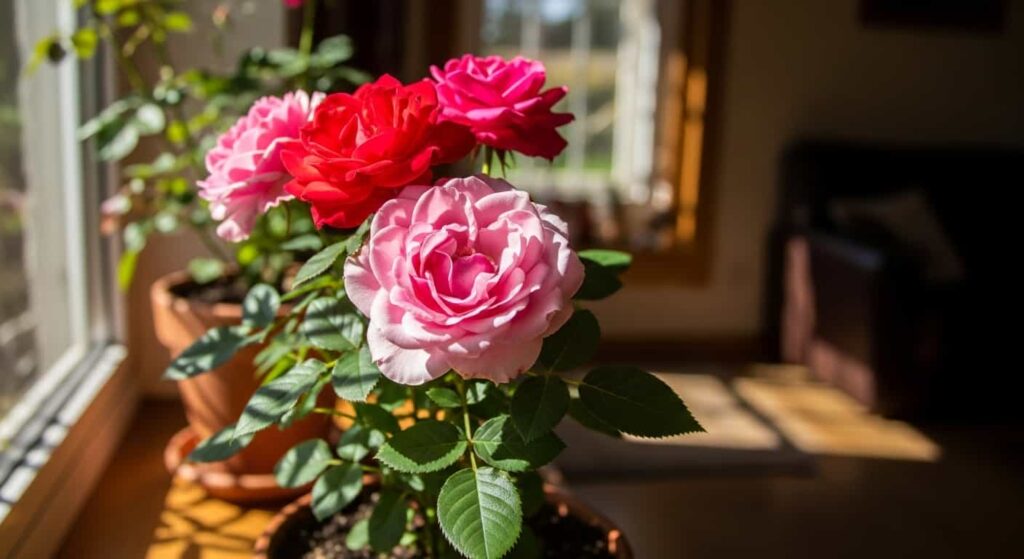
Summer is when your hard work from spring pays off. With long days and warm temperatures, your indoor rose should be in full bloom, producing a stunning display. However, the intensity of summer brings its own set of challenges, primarily related to heat, sun, and pests.
Light and Heat Management
While roses love the sun, the intense summer sun can be too much, especially when filtered through window glass, which can magnify its heat.
- Protect from Scorch: In the peak afternoon hours, the sun from a south or west-facing window can scorch leaves, causing them to turn yellow or brown at the edges. You may need to move your plant a few feet back from the window or hang a sheer curtain to diffuse the intense light.
- Maintain Air Circulation: Good airflow is crucial for preventing fungal diseases like powdery mildew, which thrive in hot, stagnant conditions. Open a window in another part of the room or use a small, oscillating fan to create a gentle breeze. Ensure the fan is not blowing directly on the plant.
- Temperature Control: Indoor roses prefer temperatures between 60-75°F (15-24°C). If your home gets much hotter than this, your rose may become stressed, leading to fewer blooms and potential leaf drop.
Watering: Staying Hydrated in the Heat
Summer heat means your rose will transpire more, losing water through its leaves and drying out its soil much faster. Your watering frequency will need to be adjusted accordingly.
- Check Daily: During hot spells, you may need to check the soil for dryness every day. The one-inch finger test remains your best guide. Don’t be surprised if you need to water every two or three days.
- Morning Watering is Best: Water your plants in the morning. This gives the foliage time to dry before evening, reducing the risk of fungal diseases. It also ensures the plant has ample water to face the heat of the day.
- Boost Humidity: Indoor environments, especially those with air conditioning, can be very dry. Roses appreciate higher humidity. You can increase humidity by placing the pot on a tray of pebbles filled with water (ensure the pot is not sitting in the water) or by using a room humidifier. Misting the leaves can provide a temporary boost, but it is less effective for long-term humidity.
Ongoing Feeding and Deadheading
To keep the flowers coming all summer long, you need to continue your feeding and grooming routine.
- Consistent Fertilizing: Continue your fertilizing schedule from spring, feeding your rose every two to four weeks with a balanced liquid fertilizer. This consistent supply of nutrients is what fuels continuous blooming.
- The Importance of Deadheading: Deadheading is the process of removing spent blooms. Once a flower starts to fade, use your fingers or clean pruning shears to snip it off, along with its stem, down to the first five-leaflet leaf. This simple action prevents the plant from wasting energy on seed production and encourages it to produce more flowers instead. Regular deadheading is one of the most effective rose plant tips for promoting a long blooming season.
Pest Patrol: Staying Vigilant
Summer is prime time for common houseplant pests like spider mites, aphids, and thrips. Be proactive in your pest management.
- Inspect Regularly: At least once a week, carefully inspect your rose plant. Check the undersides of leaves, new growth, and flower buds for any signs of pests. Spider mites, for instance, create fine webbing, while aphids are small, soft-bodied insects that cluster on new shoots.
- Act Fast: If you spot pests, act immediately. For a minor infestation, a strong spray of water can dislodge them. For more persistent problems, use an insecticidal soap or horticultural oil. Always test any spray on a small part of the plant first and follow the product’s directions carefully.
Fall: A Time for Transition and Winding Down
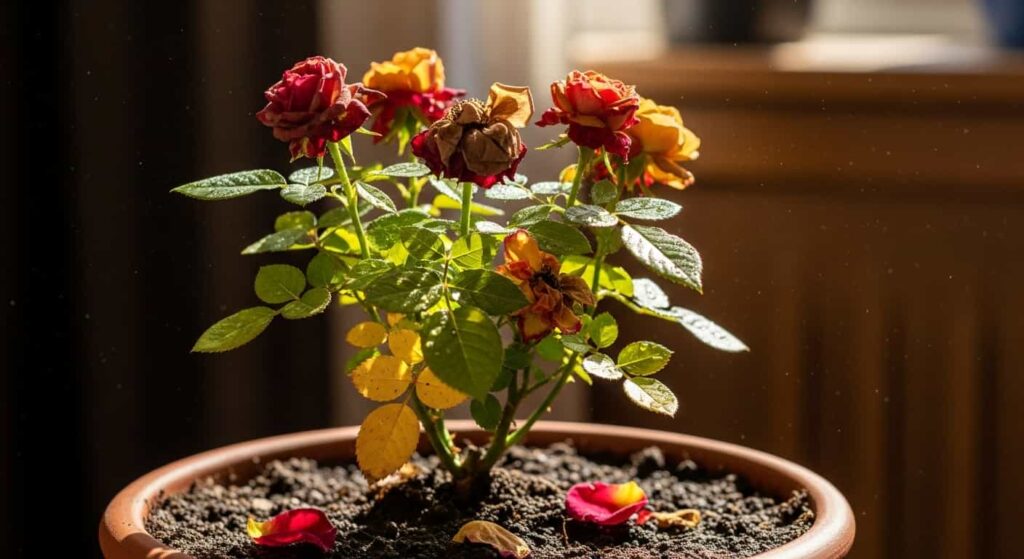
As summer fades into fall, the days shorten, and temperatures begin to drop. Your indoor rose will sense these changes and start preparing for its winter rest period. Your care routine must adapt to help the plant transition smoothly from active growth to dormancy. This is a crucial phase of seasonal gardening.
Adjusting Light and Temperature
The quantity and quality of light change dramatically in the fall.
- Chase the Sun: As the sun’s path lowers in the sky, you may need to move your rose back to a prime south-facing window to maximize its exposure to the dwindling daylight. Continue to rotate the pot to ensure even light distribution.
- Embrace Cooler Temperatures: Roses appreciate the cooler temperatures of fall. This helps signal the plant to slow its growth. Keep it away from heat vents or radiators that might trick it into thinking it’s still summer. A spot with cool nighttime temperatures is ideal.
Reducing Water and Fertilizer
The most significant change in your fall care routine will be cutting back on water and stopping fertilizer completely.
- Taper Off Watering: As the plant’s growth slows, its need for water decreases. The soil will stay moist for longer. Extend the time between waterings, relying on the finger test to guide you. Overwatering in the fall and winter is a very common mistake and can easily lead to root rot.
- Stop Fertilizing: Halt all fertilizing by early to mid-fall, about six to eight weeks before you expect the first frost in your region (even though the plant is indoors, this is a good rule of thumb). Fertilizing late in the season encourages tender new growth that will be weak and susceptible to disease during the winter. The goal is to encourage the plant to harden off and prepare for rest.
Pruning and Clean-Up
A final clean-up in the fall helps prepare your plant for a healthy winter dormancy and reduces the risk of overwintering pests and diseases.
- Light Pruning Only: Unlike the major pruning in spring, fall pruning should be minimal. Your primary goal is to remove any remaining flowers, buds, and dead or diseased leaves. This prevents them from rotting on the plant over the winter.
- Clean Up Debris: Remove any fallen leaves or petals from the soil surface. This debris can harbor fungal spores or pest eggs that could cause problems later. Maintaining a clean environment around your plant is a simple but effective part of indoor rose care.
- Final Pest Check: Before the plant enters its full dormancy, give it one last thorough inspection for pests. It’s much easier to deal with an infestation in the fall than in the middle of winter.
Winter: The Crucial Dormancy and Rest Period
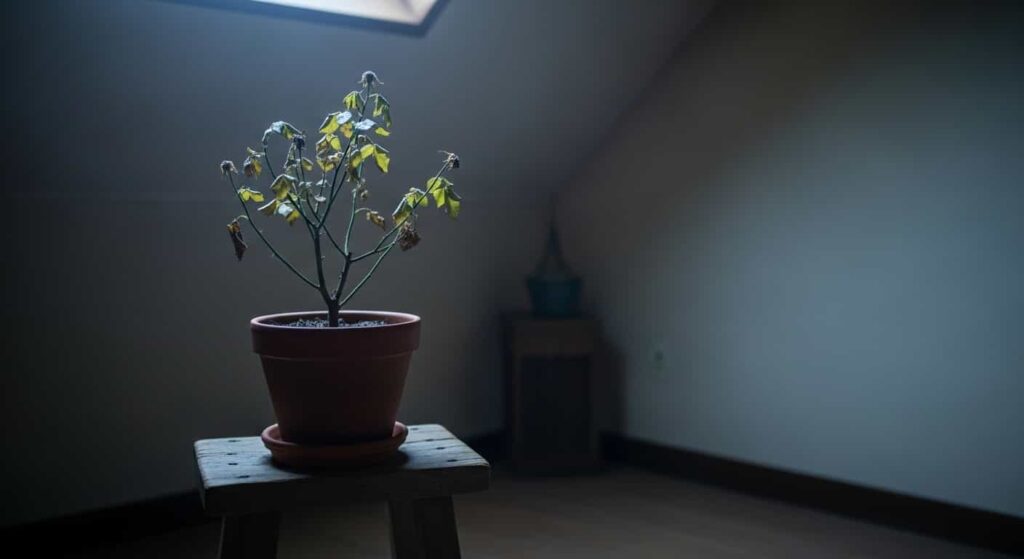
Winter is the season of rest for your indoor rose. While it may look like nothing is happening, this dormant period is essential for the plant’s long-term health. It allows the rose to conserve energy, which it will use for the burst of growth in the spring. Your main job in winter is to provide a cool, calm environment and resist the urge to over-care for it.
Providing the Right Dormant Conditions
Simulating a natural winter environment is key to successful dormancy.
- Cool and Dim: The ideal location for a dormant indoor rose is a cool, relatively dim spot. An unheated garage, a cool basement, or a chilly enclosed porch where temperatures stay consistently between 35-45°F (2-7°C) is perfect. The plant does not need significant light during this period; in fact, a lack of light helps enforce dormancy.
- What If You Don’t Have a Cool Spot? If you can’t provide such a cold environment, simply move the plant to the coolest room in your house, away from direct sunlight and heat sources. While not ideal, this “forced rest” is better than no rest at all. The plant may not go fully dormant and might keep some leaves, but reducing light and water will still encourage it to slow down.
Watering: The Bare Minimum
Watering during dormancy is the area where most gardeners go wrong. The plant’s needs are minimal.
- Just Enough to Survive: Your goal is to keep the soil from becoming completely bone-dry. The roots need to stay slightly hydrated. Check the soil every few weeks. It should feel cool and barely moist.
- How Much to Water: When you do water, give the plant only a small amount—perhaps a cup of water for a medium-sized pot. Do not soak the soil as you would during the growing season. This minimal watering prevents the roots from desiccating while avoiding the high risk of root rot in cold, wet soil.
Pruning: To Prune or Not to Prune?
There are two schools of thought on when to do the main structural pruning for indoor roses.
- Late Winter/Early Spring Pruning (Recommended): The most common and often safest approach is to wait until late winter or very early spring, just before the plant begins to break dormancy. This allows you to clearly see the healthy, live wood and the plant’s structure.
- Fall/Early Winter Pruning: Some gardeners prefer to do a hard prune after the plant has lost its leaves in the fall before moving it to its cold storage spot. This can make the plant more compact and easier to store. If you choose this method, you will still need to do a touch-up prune in the spring to remove any winter dieback.
No matter when you choose to do the main prune, the goal is to remove about one-third to one-half of the plant’s height, cut out any weak or crossing canes, and open up the center of the plant for better air circulation.
Bringing Your Rose Out of Dormancy
As late winter approaches, it’s time to start thinking about waking your rose up.
- Timing is Everything: About six to eight weeks before your area’s last expected frost date, you can begin the process of reviving your rose.
- The Process: If you haven’t already done your main pruning, now is the time. After pruning, bring the plant out of its cold, dark storage and place it in a spot with indirect light. As it begins to show signs of new growth (tiny red buds appearing on the canes), you can move it to a sunnier location and resume your spring watering and fertilizing routine. This completes the annual cycle of seasonal rose maintenance.
By following these seasonal care tips, you can enjoy the beauty of indoor roses throughout the year. Each season presents a unique opportunity to nurture your plant, from encouraging vigorous growth in the spring to guiding it through a restful winter. This attentive, year-round approach is the secret to a healthy, happy, and perpetually blooming indoor rose.

